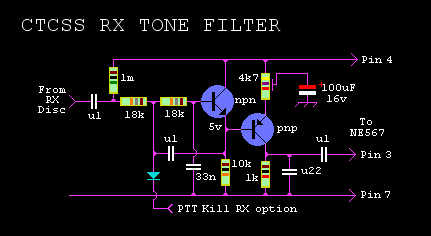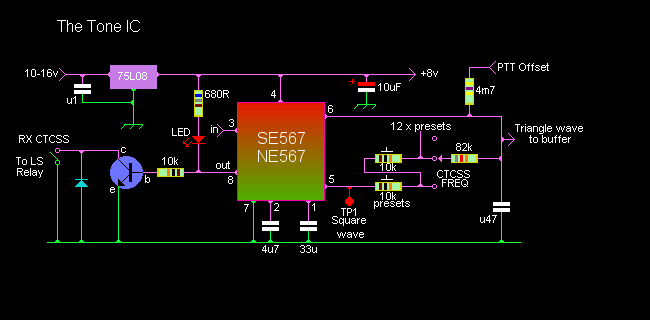This is from a talk by Andy G4WGZ on his implementation of Weyer VK2KUR's idea.
FREQUENCIES
There are 41 Continuous Tone Coded Squelch System tones in this USA designed PMR squelch system, only 9 (A-J) of the less noticeable lowest ones (not 100Hz) are used in the UK repeater network.
All in Hz 67.0 71.9 74.4 77.0 79.7 82.5 85.4 88.5 91.5 94.8 97.4 100.0 103.5 107.2 A B C D E F G 110.9 114.9 118.8 123.0 127.3 131.8 136.8 141.3 146.2 151.4 156.7 162.2 167.9 H J 173.8 179.9 186.2 192.8 203.5 206.5 210.7 218.1 225.7 229.7 233.6 241.8 250.3 256.3
Each CTCSS tone channel is only 3% wide, & with guard bands this means your frequency needs to be better than ±1% accurate for the system to work.
In the UK CTCSS tones can be used for repeaters access instead of the normal 1750Hz access tone burst, to give a selective call. (The UK recommendation from the RSGB is that repeaters should be equipped for both systems, not just one!) Note that only about half the VHF/UHF radio in use have CTCSS!
The frequencies are allocated regionally & a Morse letter is often sent with the repeater ID, to say which is in use on that repeater (A-J not I).
In practice only a few are needed from any one location, unless you want to work the Dx repeaters. CTCSS tones should be able to keep a repeater open at a higher noise level (weaker signal) than a normal squelch circuit can.
TEST KIT NEEDED
An AF frequency Counter, with 10 second gate (to 0.1Hz), or period timer mode. An AF oscilloscope is useful, A sound card scope/counter will do.
The Rx audio (from before Rx squelch) must be cut off on Tx (normally done by your rig's Rx circuit, but a diode kill option shown here if needed), or it will affect the stability of the Tx CTCSS tone frequency. The NPN makes a Butterworth

The Rx audio (from before Rx squelch) must be cut off on Tx (normally done by your rig's Rx circuit, but a diode kill option shown here if needed), or it will affect the stability of the Tx CTCSS tone frequency.
The NPN makes a Butterworth low pass filter & the PNP makes a variable gain amp also with top cut to give an overall 18dB/octave cut to reduce the amount of comms audio sent into the PLL tone IC, for better CTCSS tone detection.
The 1M bias may need selecting depending on the gain of your transistor to get about 5V on the NPN's emitter. The preset pot sets the gain of the PNP stage (1/5 to 100x) & hence the CTCSS squelch sensitivity.
 12 10k multiturn preset are all in series (any number could be uses), & mounted around a switch, they set each CTCSS frequency. Although this arrangement is troublesome to calibrate, but it gives the most fine adjustment need for these close together frequencies.
12 10k multiturn preset are all in series (any number could be uses), & mounted around a switch, they set each CTCSS frequency. Although this arrangement is troublesome to calibrate, but it gives the most fine adjustment need for these close together frequencies.
The timing capacitor 0.47u & the 82k with 1st preset set the highest frequency you need, & must be a very stable types! (Try a hot cold thermal test!)
The 4u7 & 33u set the PLL bandwidth & lock detector time. PTT offset is needed between Rx & Tx as the PLL is most sensitive when it is about 1Hz LF of the desired frequency, the 4M7 to PTT line provides this QSY shift.
The 12V relay (not shown) just disconnects the LS line, as this was an outboard design, but other muting solutions inside rigs are possible. A 2 pole CTCSS ON/OFF switch disconnects the Tx output & squelch relay so allowing the Rig to be used normally, while still while checking on what CTCSS tones are in use via the LED.

The triangle wave is buffered with the PNP & then the tips are clipped with the 2 silicon diodes to make it more like a sine wave. It is then filtered in another low pass 12dB/O Butterworth filter, to remove ALL the higher harmonic frequencies that would otherwise be audible in the comms AF channel.
The Tx output level from the Tx, (Rig input may be much higher if there is LF loss!) should be set to about -20dB (10%) of peak level, so that the tone (HUM) is not too audible! e.g. ONLY around ±250Hz deviation on a 12.5kHz system.
CALIBRATION
Frequencies: These are measured on square wave test point TP1 using a 1/10 scope probe, into a counter with 10 seconds gate time, or by using a counter in period mode & calculating the "1/f time" in mS for 1 cycle. e.g. 100Hz = 10.00mS (note the period is the time between 2 crests & not the ON time!)
As the pots are all in series, calibration MUST start at the highest frequency (min resistance) first & with the Tx operated use a dummy load so there is no RFI. As it is easy to adjust the wrong preset, mark them with the frequency.
Clipper: Scope the diode test point TP2 & adjust the clipper drive level pot to give the best near sine wave. Scoping after the filter should look like a VERY pure sine wave (<0.1% distortion).
Deviation: Rx the Tx audio on a 2nd Rx (with good LF responce) & with a scope adjust the CTCSS mic tone level to be 1/10 the height of the peak audio, this is all that is needed! Check the deviation is about right on all CTCSS frequencies.
Sensitivity: Adjust the 4k7 preset so that on just noise the CTCSS does not quite open. Check the setting on all CTCSS frequencies you have used.
IN USE
Identifying a brief CTCSS tone of a repeater is difficult as you have to be quick scanning with the switch. But other than that the unit works as expected. CTCSS Squelch Delay is very short about 1/5 second.
You should now hear only the one repeater & no "not in use repeater IDs"
(IF THE REPEATER IS CORRECTLY SET UP!).
In the UK CTCSS tones can be used for repeaters access instead of the normal 1750Hz access tone burst, to give a selective call. (The UK recommendation from the RSGB is that repeaters should be equipped for both systems, not just one!) Note that only about half the VHF/UHF radio in use have CTCSS!
The frequencies are allocated regionally & a Morse letter is often sent with the repeater ID, to say which is in use on that repeater (A-J not I).
In practice only a few are needed from any one location, unless you want to work the Dx repeaters. CTCSS tones should be able to keep a repeater open at a higher noise level (weaker signal) than a normal squelch circuit can.
TEST KIT NEEDED
An AF frequency Counter, with 10 second gate (to 0.1Hz), or period timer mode. An AF oscilloscope is useful, A sound card scope/counter will do.
The Rx audio (from before Rx squelch) must be cut off on Tx (normally done by your rig's Rx circuit, but a diode kill option shown here if needed), or it will affect the stability of the Tx CTCSS tone frequency. The NPN makes a Butterworth

The Rx audio (from before Rx squelch) must be cut off on Tx (normally done by your rig's Rx circuit, but a diode kill option shown here if needed), or it will affect the stability of the Tx CTCSS tone frequency.
The NPN makes a Butterworth low pass filter & the PNP makes a variable gain amp also with top cut to give an overall 18dB/octave cut to reduce the amount of comms audio sent into the PLL tone IC, for better CTCSS tone detection.
The 1M bias may need selecting depending on the gain of your transistor to get about 5V on the NPN's emitter. The preset pot sets the gain of the PNP stage (1/5 to 100x) & hence the CTCSS squelch sensitivity.
 12 10k multiturn preset are all in series (any number could be uses), & mounted around a switch, they set each CTCSS frequency. Although this arrangement is troublesome to calibrate, but it gives the most fine adjustment need for these close together frequencies.
12 10k multiturn preset are all in series (any number could be uses), & mounted around a switch, they set each CTCSS frequency. Although this arrangement is troublesome to calibrate, but it gives the most fine adjustment need for these close together frequencies.
The timing capacitor 0.47u & the 82k with 1st preset set the highest frequency you need, & must be a very stable types! (Try a hot cold thermal test!)
The 4u7 & 33u set the PLL bandwidth & lock detector time. PTT offset is needed between Rx & Tx as the PLL is most sensitive when it is about 1Hz LF of the desired frequency, the 4M7 to PTT line provides this QSY shift.
The 12V relay (not shown) just disconnects the LS line, as this was an outboard design, but other muting solutions inside rigs are possible. A 2 pole CTCSS ON/OFF switch disconnects the Tx output & squelch relay so allowing the Rig to be used normally, while still while checking on what CTCSS tones are in use via the LED.

The triangle wave is buffered with the PNP & then the tips are clipped with the 2 silicon diodes to make it more like a sine wave. It is then filtered in another low pass 12dB/O Butterworth filter, to remove ALL the higher harmonic frequencies that would otherwise be audible in the comms AF channel.
The Tx output level from the Tx, (Rig input may be much higher if there is LF loss!) should be set to about -20dB (10%) of peak level, so that the tone (HUM) is not too audible! e.g. ONLY around ±250Hz deviation on a 12.5kHz system.
CALIBRATION
Frequencies: These are measured on square wave test point TP1 using a 1/10 scope probe, into a counter with 10 seconds gate time, or by using a counter in period mode & calculating the "1/f time" in mS for 1 cycle. e.g. 100Hz = 10.00mS (note the period is the time between 2 crests & not the ON time!)
As the pots are all in series, calibration MUST start at the highest frequency (min resistance) first & with the Tx operated use a dummy load so there is no RFI. As it is easy to adjust the wrong preset, mark them with the frequency.
Clipper: Scope the diode test point TP2 & adjust the clipper drive level pot to give the best near sine wave. Scoping after the filter should look like a VERY pure sine wave (<0.1% distortion).
Deviation: Rx the Tx audio on a 2nd Rx (with good LF responce) & with a scope adjust the CTCSS mic tone level to be 1/10 the height of the peak audio, this is all that is needed! Check the deviation is about right on all CTCSS frequencies.
Sensitivity: Adjust the 4k7 preset so that on just noise the CTCSS does not quite open. Check the setting on all CTCSS frequencies you have used.
IN USE
Identifying a brief CTCSS tone of a repeater is difficult as you have to be quick scanning with the switch. But other than that the unit works as expected. CTCSS Squelch Delay is very short about 1/5 second.
You should now hear only the one repeater & no "not in use repeater IDs"
(IF THE REPEATER IS CORRECTLY SET UP!).